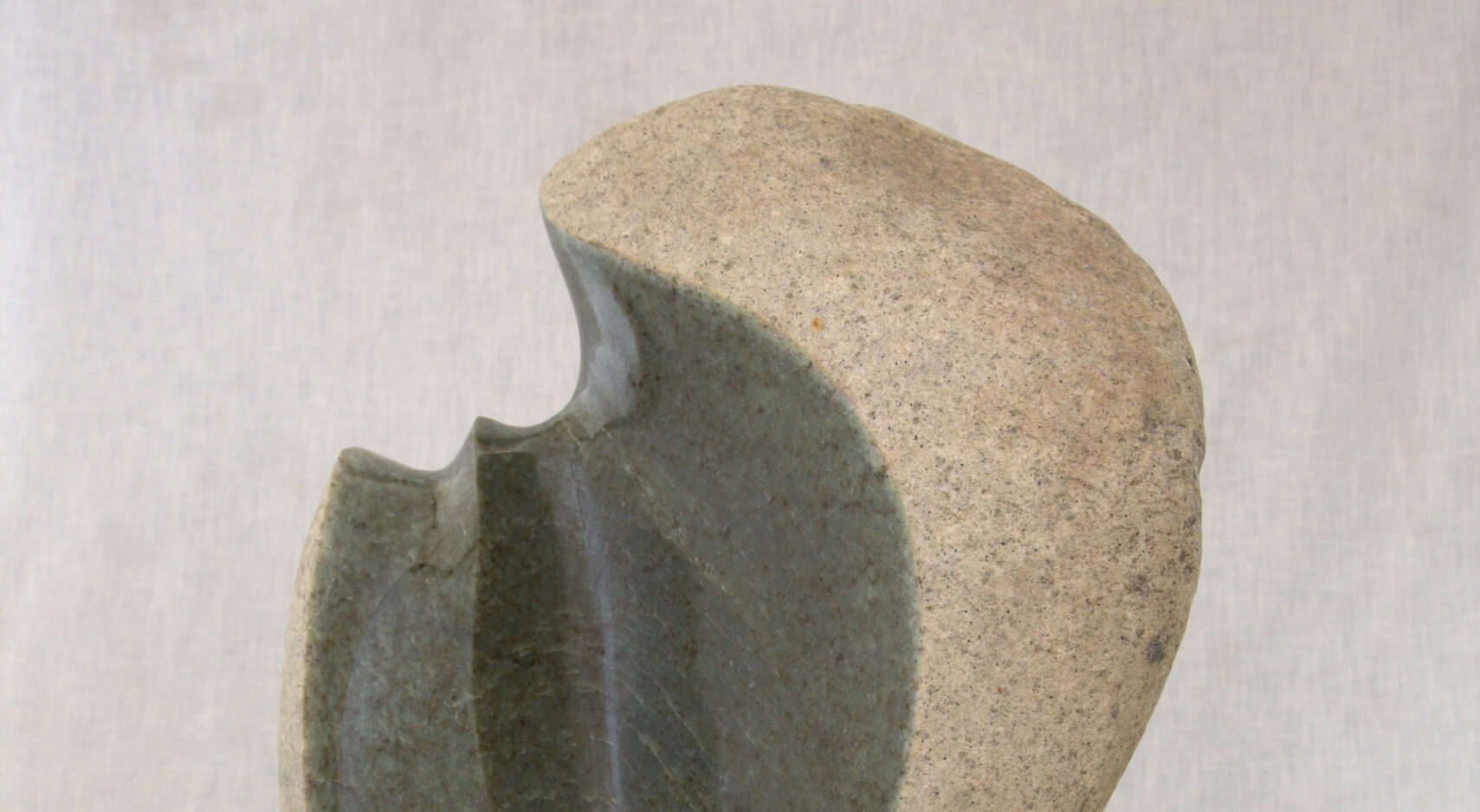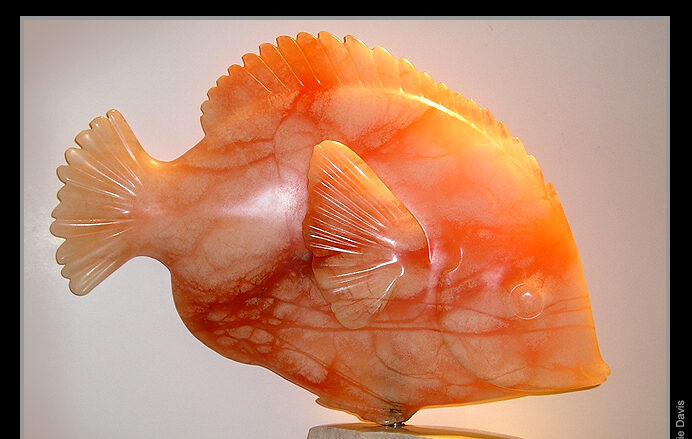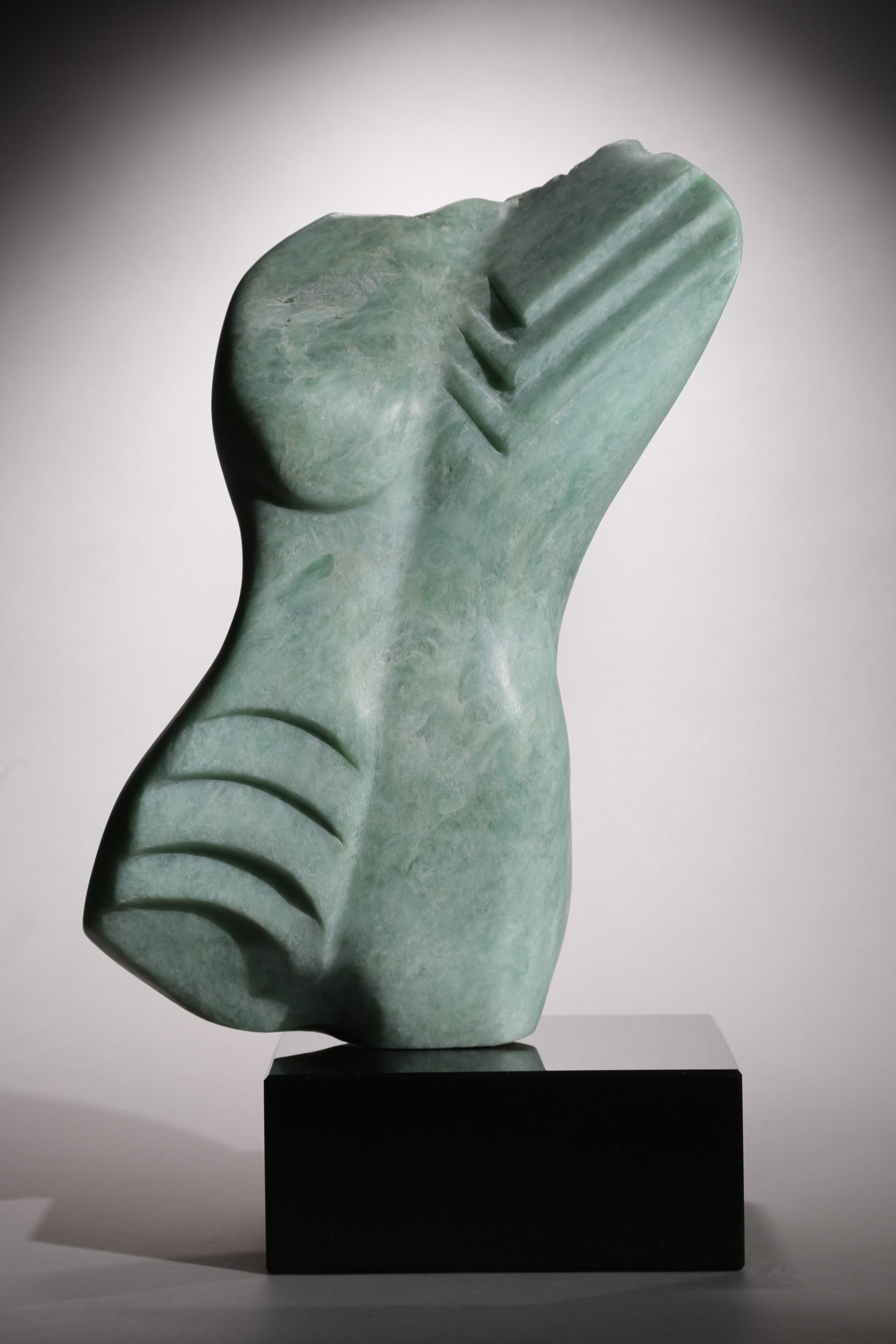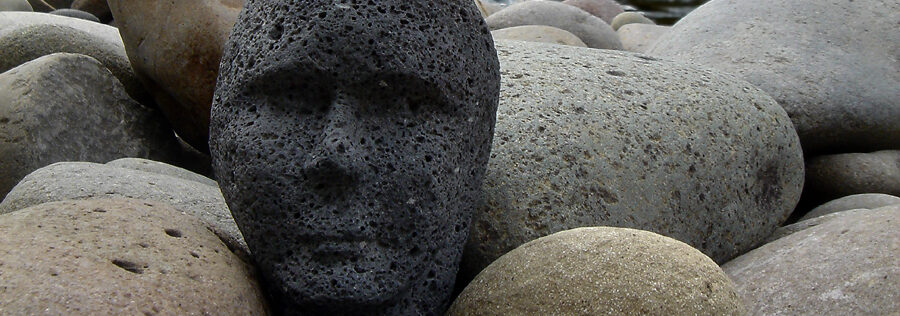
The following is an interview with Nicky Oberholtzer. Nicky has been a NWSSA member since 1990 and has been an instructor at the Whidbey Retreat and Camp Brotherhood Symposium. She is a graduate of Seattle Pacific University. I visited her at her home in Seattle. She did not have a photo of herself available for this interview, but the essence of Nicky is clearly shown by her work and her responses to my questions.
BL: What led to your becoming a sculptor?
NO: A teacher named D’Elaine Johnson. She was my high school art teacher and really inspired me to do whatever I wanted-just to respond to art forms, to enjoy forms. As a consequence, I wanted to be an artist. When I graduated from high school, my dad asked, “What do you want to do?” I said, “I want to be an artist.” He said, “No, you can’t do that. You can’t make a living at it.” I am here to tell you he is right (laughter). Because of that I denied I was an artist for years and didn’t tell anyone I did artistic things. I was always doing art in some form. I went to Sweden to learn weaving for a year. I didn’t hide my artistic interest very well apparently, because one day in church someone suggested doing something creative Everyone turned and looked’ at me and I thought, “You’re doing a really good job of being a closet artist.” That was the beginning.

At one point, my husband and I made a career change. We asked ourselves what we wanted to do and decided to stop working for other people and start working for ourselves. He decided to become a contractor; I became an artist. At that time I was going back to school for a psychology degree. I wanted to do art therapy. The nearest good degree program was in either Idaho or Oregon, which meant uprooting my family, and I didn’t want to do that. So that went by the wayside.
BL: How did you know that sculpting was what you wanted to concentrate on?
NO: I needed certain art credits and thought sculpture might be interesting. I took one class in sculpting and the stone just grabbed my soul and that was it. I changed my major to art and graduated with a BA in Fine Arts and a BA in Russian.
BL: Were there other art classes at Seattle Pacific University that were helpful?
NO: A teacher there named Larry Metcalf is absolutely wonderful in teaching design. And I also took oil painting and I still do that and pastels. I did stained glass for ten years before I went back to school.
BL: Besides sculpting, you have done oil painting, pastels and stained glass. Anything else?
NO: Clay and basket weaving. I can’t go without doing something creative at least once a week or I go nuts.
BL: What is your favorite stone to work with?
NO: I enjoy yule marble, but I hate the sanding process. I enjoy chlorite. I do a lot of alabaster, so I guess I would have to say alabaster, but I do like yule marble because of the purity of the color-the whiteness.
BL: What stone did you work with at SPU?
NO: Alabaster and soapstone.
BL: So you were using hand tools only at that time?
NO: The first class, yes. By the time I left SPU, I had been introduced to the angle grinder at a symposium.
BL: [A cat walks by] I know you like cats. Do you do any sculpture related to cats?
NO: I like to catch cats doing what they do. I don’t like trite poses. I really encourage beginners to stay away from trite poses such as the cat with the legs out front just sitting there. If you are going to do that, make it interesting. Find some other way of presenting it.
This cat is annoyed and he has decided he is going to ignore you. Cats turn and pretend to preen themselves, but they’ll let you know they’re annoyed by putting their ears back. This is what I tried to capture. I’m pleased with the result.
BL: Is that a fracture in the stone?
NO: No. those are black inclusions in the stone. It hasn’t been cracked. It’s a gorgeous stone, but one I wouldn’t use again.

BL: To me it looks like a very old piece. Like they would have done in some Chinese dynasty.
NO: Oh really. Thank you.
BL: Do you prefer working with abstract or realistic forms?
NO: I work with all of them. I talk to people who say you should stay with one or the other. I basically do what I am inspired to do. Sometimes the inspiration is from the stone. I see something in the stone and it cries to get out. Other times I find a form I like and that is a starting point. I’m a direct carver-I’m not a maquette carver. Occasionally I do drawings. Sometimes I stick to the drawing, but more often deviate considerably by the time I’m done with the stone. I let inspiration guide me.
NO: The word abstract means that you have to have known the original form in order to abstract it. You have to be able to do a good torso in order to be able to simplify it. Otherwise you are not usually going to do an effective piece. Some people are exceptions, but the majority of sculptors do abstract because they don’t think they can do a good torso or animal and they are kidding themselves. I do abstractions a lot. Usually human form or animal form. I do a lot of stylized forms. I like to do human torsos that emerge from the stone and merge back into the stone. But usually my abstracts have a basis like this piece [pointing to a piece]. It started out being a leaf and when your husband [Ward Lynch] looked at it, he said, “I see a frog there.” I talked to four or five other people and I got at least six different forms that were in that piece that I didn’t know were there. Subconsciously I probably knew they were there.
BL: Are there sculptors, living or dead, who have influenced your work?
NO: Yes, Georgia O’Keefe, Henry Moore, Brancusi, and Everett DuPen to a certain degree.
BL: Your least favorite part of sculpting is sanding?
NO: Actually not. That’s why there’s a TV in my studio. When you get to the sanding part, it’s a no-brainer, so I just turn the TV on and zone out on some kind of show. Or I talk to somebody when I’m sanding or carving. That’s why I like to do Artists in Action. If I know where I am going on a piece, I usually end up getting it roughed out by the end of the day. I’m talking to people and I don’t notice I’m working. The inspiration process is actually subconscious-I’m not aware I’m doing it. Sometimes I get home and look at the piece and say, “Whoa, that really changed!”
BL: What is your favorite part of sculpting?
NO: It’s that point where what I see in my head is realized. When I see the stone actually taking on the form that I envisioned or something even better. That, and sanding everything but marble. I haven’t found any tools that do a good job sanding so I always come back to doing it by hand. I do use diamond sanding pads. I have all the fancy sanding tools, but they sit in my closet and don’t get used.
I’m a color-oriented person. The other part of the process that I really enjoy is when you’re working a piece that is dusty and you don’t see the color. Then as you start sanding, things start appearing that you didn’t know or didn’t remember were in the stone. I like that journey of rediscovery and seeing what the stone does in conjunction with the form.
BL: Do you select your stone and look for the form in it or have an idea and then select the stone?
NO: More often than not the stone tells me what it wants to do. I look for stones that talk to me-that inspire me to see a certain form within. The stone guides me in where I’m going. However, there are times when-like the piece out on the deck that is three-quarters finis~I drew a picture and then realized it was within a stone I had.
BL: Do you bave any pieces currently in shows?
NO: Oh, yes. I bave pieces in the Issaquah Gallery, a gallery in Colorado, and one in Bellevue: I have a piece in Pioneer Park in the Puyallup Outdoor Sculpture show-a moon-shaped piece oflimestone that has a face with it’s mouth open and it’s on a triangular piece of granite. It’s a birdbath.
BL: You have been to symposiums in Colorado. Tell me about them.
NO: I like Colorado, as everyone probably knows by now. You carve in an aspen grove at 9000 feet. It meant tbat I had to be on my own and that’s a first in my 24-year marriage. I learned to work yule marble. I still don’t feel totally confident working it. Marble/marble is a wonderful workshop for beginners all the way up to advanced. I would recommend going with some knowledge of the tools because they use a lot of power tools that are huge and can be terribly intimidating. The quarry is right there. If you ever get the chance to go into a quarry, it’s really inspiring.
BL: What does your family think of you doing sculpture.
NO: The kids are annoyed when I go away for workshops because they feel it cuts into their summer. I have a 20-, a 17- and a 14-year old. They are very suppottive about what I do. I even occasionally hear, “Oh, I really like that, Mom.” My husband has been an absolute charm. He is the most supportive person in the world. When I get discouraged, he’s there to say, “You’re doing what you’re supposed to be doing. We decided that, now keep on doing it.”
I’ve talked to so many women who were taking art classes at SPU whose husbands were ridiculing them or dissuading them from doing art. I felt so sorry for them and realized how really fortunate I am. I really do feel I have a talent that God has given me and I hope I am blessing Him by using that talent my main life goal.

BL: How much of your work is done with power equipment versus hand tools?
NO: The roughing out portion is done with power tools and then I go to hand tools unless I’m doing an artist in action where you can’t do power tools. I get really frustrated in not getting close to the form. I attend a nude modeling class, started by Everett DuPen at University of Washington, but now on Mercer Island. When I go to that, I do basically hand tools. It is a good discipline. You get locked into getting to the piece too fast and need to have that discipline to realize that the stone is resistant and it is not always going to do what you want it to.
BL: How do you know when is a piece is finished?
NO: Usually when the vision I have in, my head is satisfied. Occasionally I’ll think a piece is finished and it’s not. For example, I have a show of animals in an Everett gallery and I had just finished a large turtle I was working on at the last symposium. I put it in the show and I looked at it and it’s not right. It’s
finished technically, but I don’t like it. There is something wrong with it and I’ve got to figure out what. So I will probably bring it back and stare at it for two or three months before I touch it again.
BL: Does intuition play a part in the process of your sculpting?
NO: Oh. yes, very much. Without intuition I would be a lousy sculptor. I think my carving is intuition mostly. And again [ think the stone talks to me.
BL: Tell me about your goals.
NO: I want to do monumental pieces, just like everybody else. Right now I’m restricted by what I can lift and my lack of tools, but once I’ve invested in a hoist and some other large moving tools I’d like to work life size or larger. Actually I’d like to do a couple of ex1remely large pieces. I’m doing 3 twisting sea serpent/dragon in clay right now that someday I’d like to donate to Utah to be installed on the salt flats. Driving across the salt flats is so boring, it needs some visual interest. I’d like to do it in basalt and the head would probably be about as tall as I am. That’s one of my goals.
I’m working on a piece from Marble! marble. I’ve been basically stymied and unable to work on the piece because the top part weighs about a ton and the bottom is about 12,000 pounds. I don’t have the capacity for lifting it and pinning the base. I’m hoping it can be done at the symposium with the help of some of the equipment that is up there. It’s shaped like a harp but, rather than having strings going though it, I’m opening up curlicues on one side which represent harmony and will hopefully open it up on the other side to appear like musical notes or something relating to music. The idea behind the piece is the harmony and music of life. I think it will be an excellent piece when it’s done. I have really enjoyed working on it. I am excited about seeing the end. It has been driving me nuts just sitting in my driveway.
Another piece I’m working on is related to the piece installed in Puyallup. It’s called “Loony Moon.” Again, a crescent moon and a birdbath that trickles down to a little pond underneath. It stands about four feet tall. I like to install humor in my pieces. That’s a real important component. I think pieces can be humorous and yet be a serious art piece. I think sometimes we need to laugh at ourselves. We need to laugh at the world.
BL: Would you say your “Frog With an Attitude” is an exanlple of showing humor?
NO: Yes, it’s a one of a series that I am doing. The whole series will be called “Frog With an Attitude.” The one on the lily pad was the first and was done about seven years ago. What I’m doing is taking human attributes and attitudes and putting them on frogs with the idea that when I get the whole exhibit done, people can go in and laugh at themselves. I have a couch potato frog sitting on a sofa with a beer can in one hand and a remote in the other. I have a frog with a great big grin called “What Are You Smiling At?” I’m going to do a road hog frog. A motorcycle frog. Sew a vest and have a bandanna on his head and cigarette and really have an attitude. I am hoping that people can celebrate life by laughing at themselves.
BL: Your dolphins are an example of one of your realistic pieces.
NO: That piece took fourth place at the Puyallup Fair about four years ago. It’s only about 7’x7’x 8″. It’s a piece of marble from Canada. It was a very fractured piece. People say you shouldn’t glue stone together. It has been glued together about eight times and you can’t tell. It shows how a stone can be fractured and still turn into a wonderful piece without jeopardizing the design. It took me over a year to do because there was so much damage to the stone. I had so much invested in it that I really couldn’t let it go.
BL: It looks shiny. Is there some kind of finish on it?
NO: Typically I use waxes, although I’m trying to get away from that because waxes eventually yellow andif the pieces aren’t dusted regularly-the dust tends to work its way in and dull the finish and require the piece to be refinished.
BL: Tell me about “Peace.”
NO: This is from a series. I have two series goingthe frogs and the leaf series. This piece started as a leaf form. What I would like to do one day is have a form show. I love nature. I love the variety in nature-in leaves, in flowers. That is probably what got me going. The idea is to take the leaf form and twist it and turn it. Move it in different ways but keep the idea of the leaf. I usually put some kind of an opening. I did one called “The Wave.” It’s a leaf form that is curled over on itself and looks like a wave, too. Eventually I would like to have thirty pieces, each done in a different stone-both indoor and outdoor pieces-in a leaf form. Its organic and much of my work tends to lean toward organic forms. Centered in each form is a naturally rounded river rock. The leaf form is something that I have created and the river rock is something that God’s created.
BL: Do you ever have to go into a library and research for any of your pieces or search for pictures?
NO: Yes, I do a lot of research actually. One of my best sources, and I urge beginners to do this, is go out to a Goodwill store and pick up National Geographics on whatever topic you do. Take them home and cut them up and create a file system for yourself. I’m doing a Puma Man right now. I’m not sure where it came from. There is a legend of shape changers-half man, half animal. This Native American brave is turning into a puma and it is in the middle of the change. The head is a puma, the shoulders and the upper arms will be man and the hands will be paws. It’s not something that I have done before. It is a branching out for me. In order to do the puma face right, I went out and researched cats.ln order to do the chest right, I went out and got a Playgirl because it is very hard to find good male models that are built like I wanted this figure to be.
BL: Would you like to give me a statement of your philosophy?
NO: Celebrate life. I struggled for many years trying to figure out what I’m trying to say; what my heavy message is. What penetrating thought do I want to share with others? The one thing that we don’t do is really look at life intently. In order to do a bird, you have to spend time looking at it. I go to the zoo and the aquarium and spend hours staring at subject matterhow they stand, how they turn and twist, how they rest, how they swim. I try to capture that life in my sculpture rather that just doing a static form. In order to do that, you have to learn to love the form and to understand it. There is a celebration of life that seems to come out of that study.
Go to a nude modeling class. Study the human form. It is fascinating. You’ll never see the same form twice. It’s an endless variety of shapes and colors and sizes.
BL: How has NWSSA influenced you?
NO: It has been great. I have learned a lot. What is so valuable about it is the networking. Also the access to tools, information about tools and stone. One of my biggest frustrations in 1990, when I was getting started, was finding stone, so I started acquiring it myself. Because of this, I have learned a lot about stone. Going to the symposium is like being in an encyclopedia on stone and tools. You visit other peopIe’s studios and you learn so much seeing other people’s processes at the symposium and getring tips on things. I like the friendliness. When I joined the Northwest Stone Sculptors Association-I know nobody is going to believe this-I was extremely shy. The Association helped me open up and be who I want to be. I would encourage people who go to the symposium to be gentle with beginners. They are very fragile.
BL: What things do you teach?
NO: I teach hand tools, pneumatics, design, and paper making. I have also been asked to jury at the state fair this year. This is the second time they have asked me. The first time I couldn’t because I was going to be gone. It is really an honor to be asked.
BL: Do you suggest people start with power tools?
NO: One thing about sculpting is that it is a series of stages. People start out usually (there are exceptions to every rule) using hand tools, go to electric tools, and graduate to pneumatics. It doesn’t have to be in that order but often the cost dictates the way you have to go.
I look at sculpting as a series of goals and steps. This year I have realized two goals. I have a piece in Puyallup that is a step towards a monumental piece. My other goal was to be asked to judge a show. That was a goal that I didn’t expect to achieve for a number of years. So now I have to ask myself, “What is my next goal?”
BL: Thanks, Nicky.
Editor’s note: because of the length of this interview, parts of it were cut for use at a later date.











We need some kind of descriptive text here.